Mad Hedge Biotech and Healthcare Letter
March 18, 2025
Fiat Lux
Featured Trade:
(WHEN THE MARKET GIVES BACK WHAT IT ONCE TOOK AWAY)
(ABT), (ISRG), (SYK), (BSX)
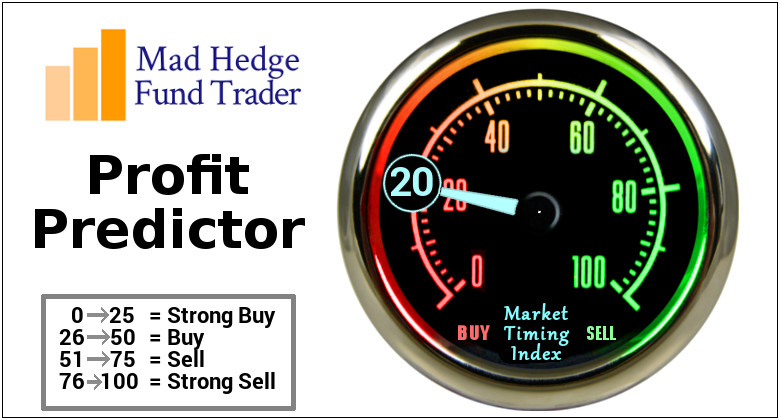
Mad Hedge Biotech and Healthcare Letter
March 18, 2025
Fiat Lux
Featured Trade:
(WHEN THE MARKET GIVES BACK WHAT IT ONCE TOOK AWAY)
(ABT), (ISRG), (SYK), (BSX)

If Wall Street had a confessional booth, I'd be first in line. "Forgive me, market gods, for I underestimated how quickly sentiment could shift."
When I last wrote about Abbott Laboratories (ABT), the market was treating this medical device powerhouse like last week's leftovers—despite growth that would make most CEOs weep with joy.
Fast forward a few months, and Abbott's stock has rocketed 25%, outpacing the broader medical device sector by about 20%.
It has kept stride with Boston Scientific (BSX) while leaving Intuitive Surgical (ISRG) and Stryker (SYK) eating dust.
This kind of market whiplash reminds me of reporting from Tokyo trading floors in the 1980s—fortunes changing direction faster than a day trader after espresso, fundamentals barely shifting while sentiment performed aerial gymnastics.
So what changed? Abbott became a flight-to-safety darling.
While economic storms gather, it sits comfortably in its non-elective procedure fortress, with minimal tariff exposure and a recent legal victory reducing liability concerns.
The irony? Sentiment has now sprinted ahead of business performance. While Abbott remains a leader, its valuation leaves little room for missteps.
And if I'm overpaying for med-tech, I might as well reach for Boston Scientific instead, where growth is comparable but the valuation looks more reasonable.
Abbott’s fourth-quarter results weren’t showstopping, but they were reassuring.
Revenue landed slightly below expectations in some areas, but crucial segments—like Medical Devices—delivered strong results. Meanwhile, profit margins surprised pleasantly, reinforcing Abbott’s operational strength.
Overall revenue grew 9% organically, with Medical Devices leading at 14% growth.
The Diagnostics division posted just 1% growth, but that’s misleading—strip out COVID-19 testing effects, and underlying growth jumps to 6%.
Margins impressed, too. Gross margin improved to 56.9%, and adjusted operating income climbed 10%.
Abbott even managed a narrow revenue beat while missing slightly on EBITDA and free cash flow, largely due to tax timing that caught most analysts off guard.
I've spent decades analyzing companies across multiple sectors, and I can tell you Abbott’s medical device business deserves genuine admiration.
It maintained 14% growth from start to finish—a remarkable consistency while competitors slowed from 9.5% to 9.2% growth during the same period.
Looking at the fourth-quarter specifics, Structural Heart shone with 23% growth, outpacing Boston Scientific’s 20% and Medtronic’s 12%.
The Diabetes segment posted an impressive 20% growth, more than doubling DexCom’s 8%. Even in slower segments like Cardiac Rhythm (7%) and Neuromodulation (8%), Abbott still outperformed key competitors.
The bottom line: Abbott is executing at an exceptional level across its device portfolio.
Even its Diagnostics business, with 6% underlying growth, holds up well against Roche’s 8% and substantially outperforms Siemens Healthineers’ anemic sub-1% and Danaher’s 2% contraction.
There are three developments that investors should be paying attention to.
First, Abbott’s exposure to new tariffs is minimal—just 5% of COGS from Mexico and 1% from China. This translates to a low single-digit EPS impact, barely a rounding error in today’s environment.
Second, TriClip may have more growth potential than I previously thought. Recent data from Edwards Lifesciences’ (EW) competing Evoque device showed no mortality benefit and only modest hospitalization improvements.
This lets Abbott position TriClip as the safer approach without sacrificing quality-of-life benefits.
Third—and most significant—Abbott won a crucial legal victory in October regarding its infant formula.
A jury unanimously found the company not at fault in a necrotizing enterocolitis case, though the judge recently granted a new trial.
With 10,000 cases still pending, this development could strengthen Abbott’s settlement position and potentially cap damages below $1 billion—substantial but manageable.
I expect slight moderation next year, but Abbott should still deliver 7% growth over the next three to five years.
Newer products like Lingo (blood glucose monitoring for non-diabetics) are performing well, with significant potential in Amulet and upcoming PFA and lithotripsy offerings.
On margins, I expect EBITDA to climb above 28% within four years, with free cash flow margins reaching high-teens to low-20%.
This should drive high single-digit to low double-digit FCF growth—performance that typically earns management teams effusive praise.
Valuation, however, is challenging after the recent surge. My former 5x revenue multiple only gets to around $125, while a more aggressive 6x model approaches $150—making me about as comfortable as a cat in a dog show.
I’m surprised by how quickly sentiment shifted on Abbott, likely due to investors seeking safety amid economic uncertainty.
Whether this outperformance has staying power remains uncertain, but Abbott is certainly delivering growth that matches or exceeds competitors across most business lines.
For now, I'm watching Abbott with the same fascination I once had for Sierra mountain expeditions—impressed by the ascent but keenly aware that the air gets thinner the higher you climb.
After all, what's that old market adage? Oh right—the view is spectacular, but nobody rings a bell at the top.

Mad Hedge Biotech and Healthcare Letter
November 12, 2024
Fiat Lux
Featured Trade:
(BONE OF CONTENTION)
(AMGN), (NVO), (LLY), (PFE), (VKTX), (GPCR), (AZN)

Mad Hedge Biotech and Healthcare Letter
November 12, 2024
Fiat Lux
Featured Trade:
(MEDTECH’S TRUMP CARD)
(RMD), (STE), (TNDM), (JNJ), (BDX), (MDT), (BSX), (SYK), (ZBH)
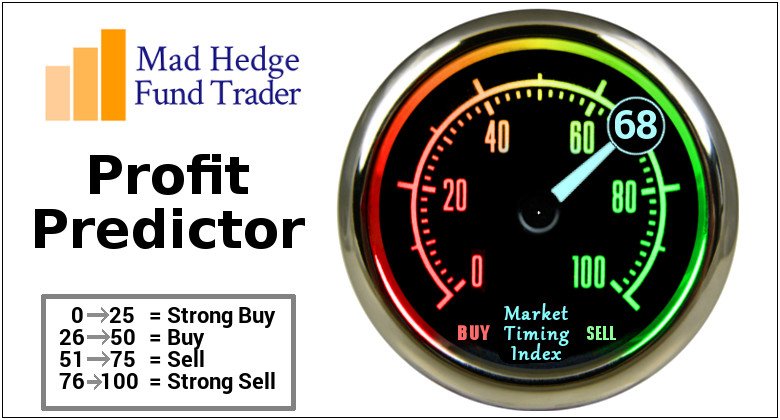
After seeing Trump sweep back into office, my phone's been ringing off the hook with one question: "What happens to my portfolio now?"
Look, I've been around this circus since covering Reagan in the White House press corps, and I can tell you that market hysteria rarely matches reality.
But this time, we need to pay attention - especially in the $567 billion medtech industry that's about to face some serious disruption.
What's different now? Trump's not just talking about those 10% to 20% blanket tariffs anymore - he's dead serious about slapping a potential 60% tariff on Chinese imports.
And after spending years watching supply chains twist themselves into pretzels during COVID, this is going to hit different.
To understand just how big this could be, let's look at what's really at stake here.
In vitro diagnostics makes up 18% of the medtech industry, and cardiology devices are sitting at $75 billion in 2024, expected to hit $95 billion by 2028.
Those aren't just numbers on a page - they represent real money that could take a serious hit. If these tariffs go through, we're looking at a 3.2% hit to S&P 500 earnings per share in 2025.
And it gets worse - add another 1.5% drop if our trading partners decide to play hardball with retaliatory tariffs.
Given all this, where should you put your money? The answer lies in looking at who's already ahead of the curve.
Well, established players like Johnson & Johnson (JNJ) and Becton Dickinson and Co. (BDX) are looking increasingly shrewd with their local-for-local manufacturing strategy.
They might not give you the same adrenaline rush as scaling Mount Everest, but they're solid holds in this environment.
But they’re not the only companies securing their positions. ResMed (RMD), for instance, just posted third-quarter sales up 11% to $1.22 billion, with adjusted earnings jumping 34% to $2.20 per share.
That's not just good numbers - that's a company that knows how to execute regardless of who's in the White House.
In the same vein, Steris deserves attention. Their "front-shoring" strategy in Malaysia isn't just smart - it's prescient. After years of covering Asia for The Economist, I can spot smart positioning when I see it.
Now, let's talk about some of the bigger players in the room. Medtronic (MDT), our industry giant, is giving me pause.
Sure, they're a global leader, but their heavy reliance on Chinese manufacturing and components is about to become a serious headache under these new tariffs.
Same story with Boston Scientific (BSX) - they've got manufacturing facilities in China that could turn from assets to liabilities pretty quickly.
Stryker (SYK) and Zimmer Biomet (ZBH) are in the same boat, but with a twist. Both companies have been smart enough to spread their supply chains globally, but they're still catching enough Chinese exposure to make me nervous.
When those tariffs hit their component costs, watch their margins. This isn't just about bottom lines - it's about how much wiggle room these companies have to absorb higher costs without passing them on to hospitals and patients.
On the flip side, I'm watching companies like Tandem Diabetes Care (TNDM) with growing concern.
Their heavy Asian supply chain exposure under Trump's trade policies is going to be about as comfortable as my MIG-25 flight at 90,000 feet - and trust me, that wasn't comfortable at all.
But, what’s really telling is where the smart money is flowing.
Keep your eyes on three key trends that are reshaping the industry: supply chain resilience, M&A activity (now up 18% to $57.7 billion), and digital transformation.
About 30% of medtech companies are getting serious about digitizing their operations - and they're the ones to watch.
So, here's my bottom line: Trump's return is going to shake up medtech, but not every tremor is an earthquake.
The winners in this new landscape will be companies that have already diversified their manufacturing outside China, built up strong balance sheets to absorb these tariff impacts, and proven they can adapt - like ResMed and Steris have shown us.
The real champions will be those making serious investments in digital transformation. These are the companies that won't just survive Trump's trade policies - they'll thrive under them.
And if you're still holding onto companies with heavy Chinese exposure?
Well, let's just say it might be time to look for higher ground - and I'm speaking as someone who's made that call at both 20,000 feet on Everest and during the 2008 crash.
The medtech industry isn't going anywhere - people will always need medical devices. But which companies thrive under Trump's second term? That's going to depend on who's prepared for the storm and who's still standing in the open.
Now, if you'll excuse me, I've got some vintage wine to open. Making sense of these markets is thirsty work.

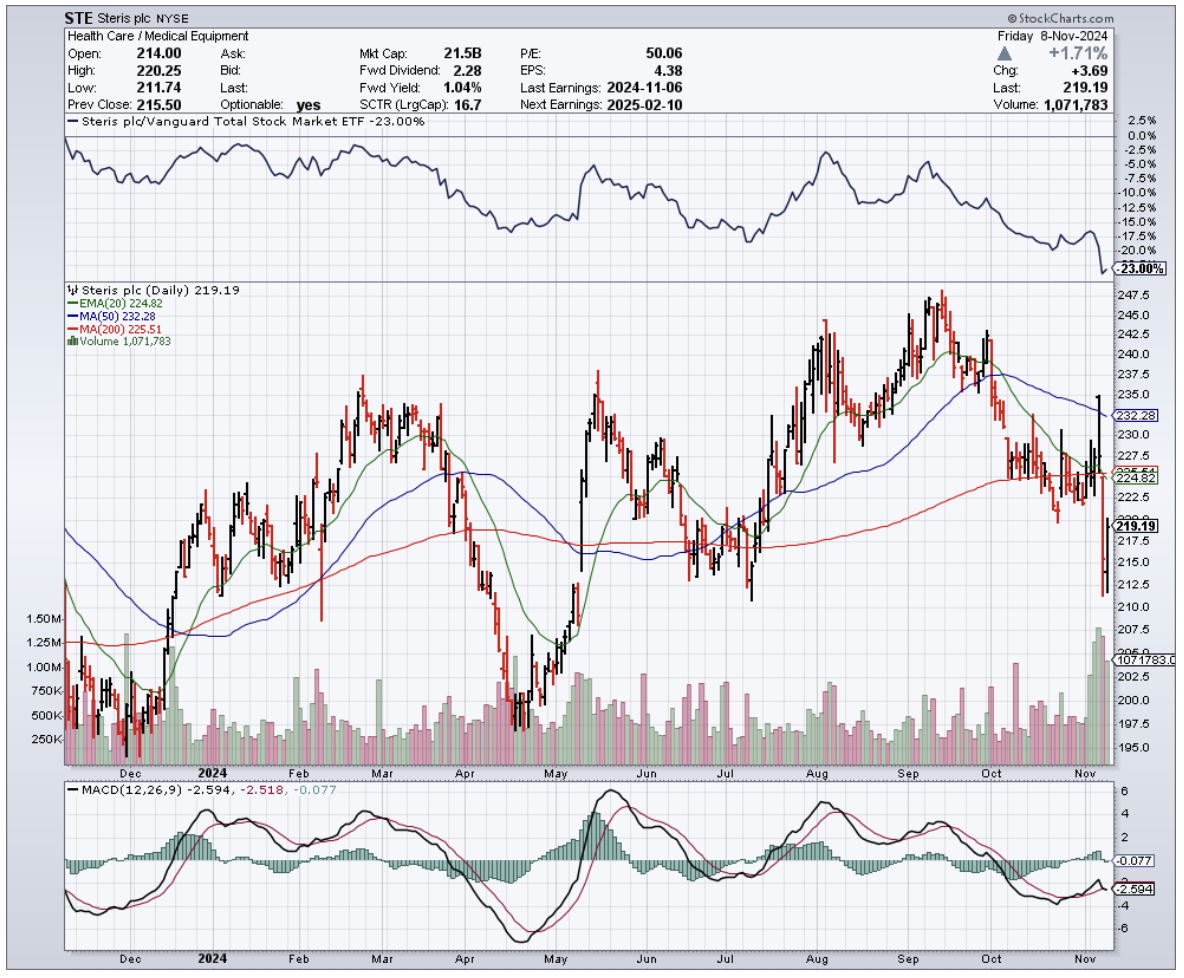
Mad Hedge Biotech and Healthcare Letter
September 21, 2023
Fiat Lux
Featured Trade:
(HEALTH MEETS WEALTH)
(BSX), (ABT), (JNJ), (MDT), (SYK)

In a state-of-the-art medical facility, a surgeon's hands move with precision, guiding a catheter towards the basivertebral nerve. Their mission is clear: to halt the persistent pain signals traveling to the brain, offering relief to those burdened by vertebrogenic pain. This is the real-world application of the Intracept system, a breakthrough in healthcare.
Boston Scientific Corporation (BSX) has recently made headlines by announcing its definitive agreement to acquire Relievant Medsystems, Inc., the very creators of the Intracept Intraosseous Nerve Ablation System. This power move, sealed with a cool $850 million upfront cash payment, also includes some exciting performance-based bonuses over the next three years.
Let's zoom in on the Intracept system for a moment. It's the only kid on the block with a nod from the U.S. Food and Drug Administration, specifically tailored for vertebrogenic pain. This sleek, implant-free outpatient procedure employs radiofrequency energy, acting like a mute button for the pain-causing basivertebral nerve.
And with over 5.3 million Americans wrestling with vertebrogenic pain, the ripple effect of this innovation is monumental. So, mark your calendars: the acquisition is set to be finalized in the first half of 2024 once all the formalities are squared away.
On the financial front, the future's looking bright for Relievant. They're gearing up to clock sales north of $70 million in 2023, with a growth spurt expected to zoom past 50% in 2024. And while the 2024 earnings per share (EPS) might not cause a big splash, 2025 and beyond are looking sunny.
While the acquisition is a major step, Boston Scientific's journey doesn't stop there.
Their Watchman device, which dominates its market segment, is poised to bring transformative changes to atrial fibrillation treatments. Just think of this gadget as a guardian angel for patients with non-valvular atrial fibrillation, shielding them from stroke risks without the ball-and-chain of long-term blood thinners.
Apart from this, Boston Scientific dropped some exciting news earlier this year about their ADVENT Study of the FARAPULSE Pulsed Field Ablation System (PFA). This nifty gadget uses electric fields to treat atrial fibrillation (AF), sidestepping the need to heat up the tissue. The study was a trailblazer, being the first to pit the FARAPULSE system against traditional AF treatments.
However, Boston Scientific's game plan goes beyond just gadgets and gizmos.
Their keen interest in Shockwave (SWAV) and a track record of smart acquisitions hint at a company that's always two steps ahead. This forward-thinking mindset has earned them nods of approval from both the medical community and sharp-eyed investors. The success of its ADVENT study, for instance, has further underscored its growing prominence in the sector.
In today's roller-coaster financial world, with storm clouds of economic downturns gathering, investors are on the hunt for solid ground. This is where Boston Scientific comes through. They're not just a safe harbor; they're also a vessel of growth.
With two solid quarters in the bag and a projected 11% revenue growth on the horizon, they're on a skyward journey. And while there might be some chatter about its share valuation, their blend of innovation and strategy makes every penny worth it.
In a nutshell, Boston Scientific is more than a company name; it's a promise of a brighter, healthier tomorrow. Moreover, the stock has consistently outpaced the broader medical device sector, gaining an edge of about 10% over notable competitors like Abbott (ABT), Johnson & Johnson (JNJ), Medtronic (MDT), and Stryker (SYK). This performance was evident even before the company unveiled the impressive results of its ADVENT study on the Farapulse ablation.
Currently, I remain optimistic about the potential of BSX shares. Granted, a forward revenue multiple of 6.5x isn't exactly modest, and the valuation might appear ambitious when assessed through traditional metrics like discounted free cash flow. However, top-tier growth med-tech stocks rarely come with a discount tag.
Given the prospects of Farapulse, Watchman label extension studies, innovative CRM products, the Agent drug-coated balloon, and growth avenues in peripheral intervention, endoscopy, and urology, Boston Scientific stands out as a unique growth narrative. Historically, investors have shown a willingness to pay premium multiples for such consistent growth in this market segment.
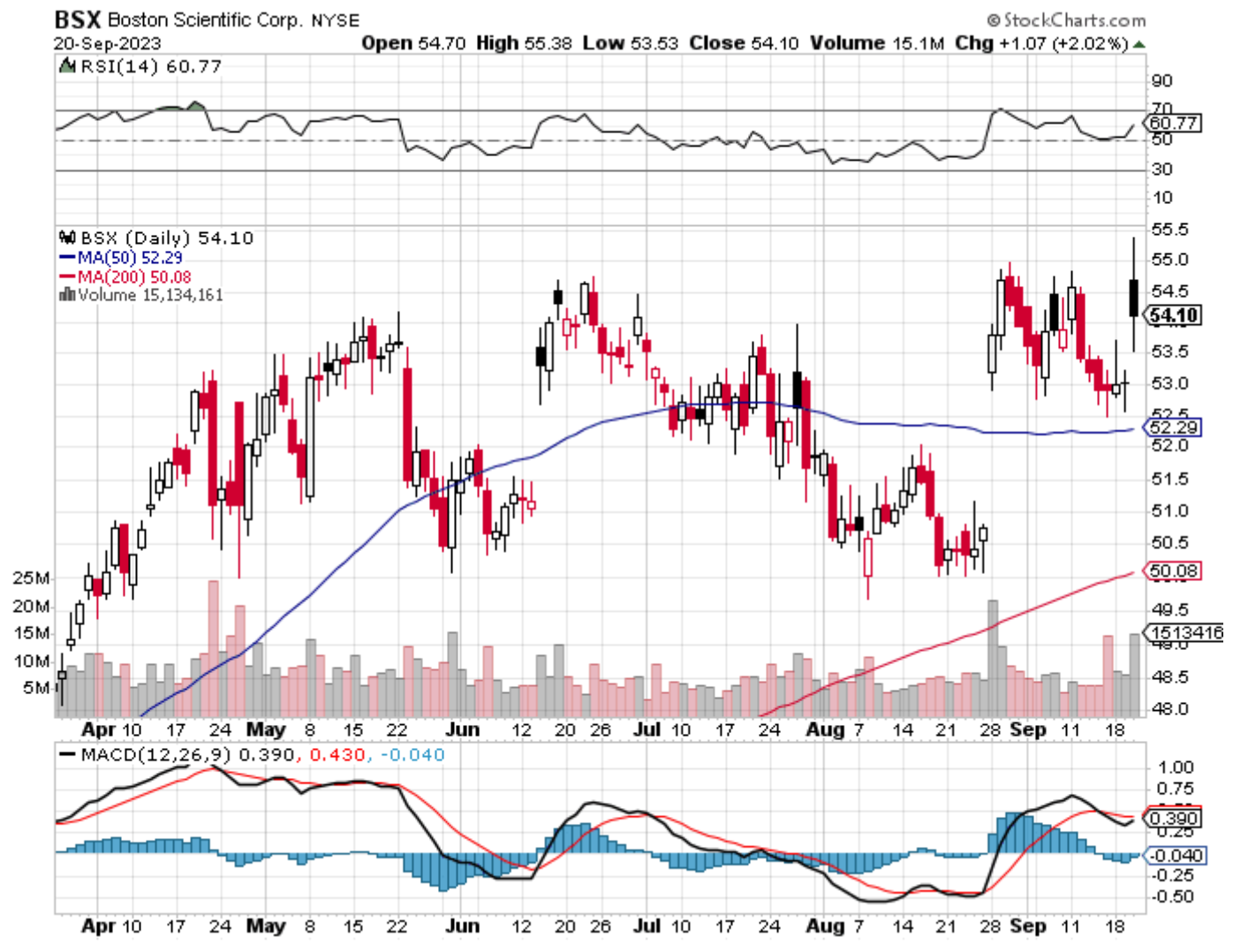
Mad Hedge Biotech and Healthcare Letter
May 18, 2023
Fiat Lux
Featured Trade:
(INVESTMENT OPPORTUNITIES AMIDST UNCERTAINTY)
(SYK), (MDT)

As this bear market lingers, my attention keeps gravitating toward healthcare and insurance stocks.
Why, you ask? Well, let me break it down for you into three compelling points that make them enticing options for investors, especially when the market isn't at its finest.
First, there's the allure of steady demand. You see, healthcare insurance isn't just a luxury or a fleeting trend—it's a necessity. No matter the economic landscape, people will always require healthcare services, ensuring a consistent demand. And when it comes to investing, stability, and predictability are music to my ears. I mean, who doesn't appreciate a good dose of stability and predictability?
Second is the potential for growth. As the American population continues to age and healthcare costs skyrocket, the need for reliable healthcare insurance providers becomes more pronounced. It's like witnessing a golden opportunity for growth unfold right before our eyes. While I typically lean towards income-focused investments, the idea of capitalizing on an industry that has growth potential when others are merely treading water? Well, that's quite appealing, isn't it?
Third is its resilience to economic downturns. This one's a game-changer. When the economy takes a nosedive, people tighten their belts and cut back on discretionary spending. However, healthcare is an area where they're reluctant to compromise. It takes precedence. So, even in the face of economic turmoil, healthcare insurance providers remain steadfast. They possess an inherent ability to weather the storm and come out stronger. And let me tell you, that's the kind of resilience that can truly make a difference in your investment portfolio.
A promising contender in my search for long-term healthcare stocks is Stryker Corporation (SYK).
With a market capitalization of $113 billion, it ranks second globally, just behind Medtronic (MDT). Established in 1941, Stryker is a leading technology company specializing in the development and production of medical devices and equipment. Operating across multiple healthcare niches, Stryker holds a prominent position as one of the world's largest medical technology firms, focusing on three niches.
One is orthopedics, where the company focuses on the creation of devices for joint replacement, trauma care, spinal repair, and complementary surgical instruments.
Another is the MedSurg segment, which specializes in the development and manufacturing of medical and surgical equipment, encompassing endoscopic and imaging systems, as well as powered surgical tools.
The last is its Neurotechnology and Spine segment, which provides an array of cutting-edge neurosurgical and spinal devices, including advanced implants, instruments, and biologics.
The aging population, with its accompanying surge in healthcare demand, presents a goldmine of opportunities for Stryker. With a comprehensive array of medical and surgical solutions, Stryker is well-equipped to cater to the evolving needs of this expanding demographic.
As the elderly population increases and their healthcare requirements surge, Stryker stands poised to capitalize on this significant market shift. Moreover, the company is at the forefront of innovation in the field of orthopedics.
Recognizing the growing number of hip and knee replacement surgeries performed on an aging population, Stryker made a game-changing move in 2013 by acquiring the Mako robotic-arm-assisted surgery system.
The Mako system is a remarkable combination of cutting-edge technology and surgical expertise. Picture a robotic arm seamlessly integrated into the surgical process, guided by a skilled surgeon and a sophisticated computer system.
What sets the Mako system apart is its ability to achieve remarkable precision. By meticulously placing the implant with pinpoint accuracy, the system ensures better alignment, enhanced stability, and improved overall joint function.
But Stryker's efforts to innovate don’t end with the Mako system.
Their dedication to advancing medical technology is evident in their other divisions as well. In the field of endoscopy, Stryker has developed advanced visualization systems that enhance the accuracy and efficiency of minimally invasive surgeries. These systems provide surgeons with a clear and detailed view of the surgical site, empowering them to perform procedures with greater precision and effectiveness.
Stryker's initiatives in research and development also continue to yield impressive results.
Just last September 2022, they introduced the Q Guidance System, a groundbreaking navigation software designed to aid surgeons in surgical planning and execution. With the FDA's approval for usage in pediatric patients aged 13 and above, this software elevates the standards of computer-assisted surgeries. By simplifying preoperative planning, navigation, and execution, the Q Guidance System takes surgical precision to new heights.
And that's not all.
The company also aims to address bone fractures. Their recent launch of the Gamma4 System demonstrates their dedication to helping orthopedic surgeons treat both stable and unstable fractures effectively.
It's clear that Stryker is pushing the boundaries of medical technology.
But more impressively, these launches were just the tip of the iceberg when it comes to the flurry of exciting product releases that have been making waves over the past year, contributing to a remarkable 13.2% surge in Stryker's organic net sales for the quarter.
Thanks to strategic acquisitions in Stryker's medsurg and neurotechnology divisions, net sales experienced an additional boost of 1.3%. However, let's not forget the mischievous foreign currency translation, which played the spoilsport, causing a 3.8% decline. Blame it on the company's extensive global presence and the disproportionately robust U.S. dollar.
Sure, Stryker's current dividend yield of 1.1% might not have income investors doing cartwheels when compared to the S&P 500's 1.6% yield. But hold your horses, because that's not where this company truly shines.
Stryker has practically tripled its quarterly dividend per share, going from a humble $0.265 in 2013 to a robust $0.75 this year, making it a bona fide dividend growth stock.
And here's the cherry on top: with a dividend payout ratio expected to hover just below 30% in 2023, Stryker has plenty of room to stretch its dividend muscles further.
This low payout ratio allows the company to allocate capital towards strategic acquisitions, debt reduction, and share repurchases. In other words, it's a recipe for fueling future adjusted diluted EPS growth.
Peering into the crystal ball, the future looks bright for Stryker over the next five years. Stryker knows how to keep the growth engine revving by channeling their efforts into research and development. By continuously fine-tuning their existing products, they ensure steady progress, even if it doesn't set the world on fire due to the more laid-back pace of their markets.
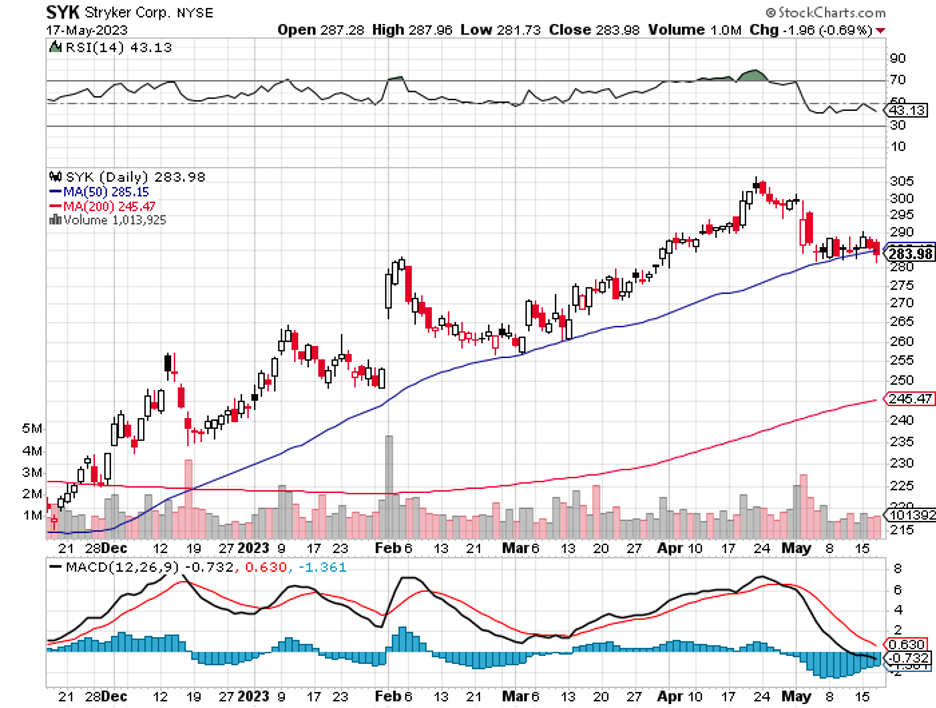
Mad Hedge Biotech and Healthcare Letter
March 1, 2022
Fiat Lux
Featured Trade:
(THE FUTURE OF SURGERY)
(ISRG), (MDT), (SYK), (ZBH), (JNJ)

Legal Disclaimer
There is a very high degree of risk involved in trading. Past results are not indicative of future returns. MadHedgeFundTrader.com and all individuals affiliated with this site assume no responsibilities for your trading and investment results. The indicators, strategies, columns, articles and all other features are for educational purposes only and should not be construed as investment advice. Information for futures trading observations are obtained from sources believed to be reliable, but we do not warrant its completeness or accuracy, or warrant any results from the use of the information. Your use of the trading observations is entirely at your own risk and it is your sole responsibility to evaluate the accuracy, completeness and usefulness of the information. You must assess the risk of any trade with your broker and make your own independent decisions regarding any securities mentioned herein. Affiliates of MadHedgeFundTrader.com may have a position or effect transactions in the securities described herein (or options thereon) and/or otherwise employ trading strategies that may be consistent or inconsistent with the provided strategies.
This site uses cookies. By continuing to browse the site, you are agreeing to our use of cookies.
OKLearn moreWe may request cookies to be set on your device. We use cookies to let us know when you visit our websites, how you interact with us, to enrich your user experience, and to customize your relationship with our website.
Click on the different category headings to find out more. You can also change some of your preferences. Note that blocking some types of cookies may impact your experience on our websites and the services we are able to offer.
These cookies are strictly necessary to provide you with services available through our website and to use some of its features.
Because these cookies are strictly necessary to deliver the website, refuseing them will have impact how our site functions. You always can block or delete cookies by changing your browser settings and force blocking all cookies on this website. But this will always prompt you to accept/refuse cookies when revisiting our site.
We fully respect if you want to refuse cookies but to avoid asking you again and again kindly allow us to store a cookie for that. You are free to opt out any time or opt in for other cookies to get a better experience. If you refuse cookies we will remove all set cookies in our domain.
We provide you with a list of stored cookies on your computer in our domain so you can check what we stored. Due to security reasons we are not able to show or modify cookies from other domains. You can check these in your browser security settings.
These cookies collect information that is used either in aggregate form to help us understand how our website is being used or how effective our marketing campaigns are, or to help us customize our website and application for you in order to enhance your experience.
If you do not want that we track your visist to our site you can disable tracking in your browser here:
We also use different external services like Google Webfonts, Google Maps, and external Video providers. Since these providers may collect personal data like your IP address we allow you to block them here. Please be aware that this might heavily reduce the functionality and appearance of our site. Changes will take effect once you reload the page.
Google Webfont Settings:
Google Map Settings:
Vimeo and Youtube video embeds:
